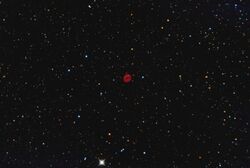Astronomy:Abell 48
| Emission nebula | |
|---|---|
| Planetary nebula | |
 Abell 48, imaged by Jerry Macon | |
| Observation data: J2000.0 epoch | |
| Right ascension | 18h 42m 46.921s[1] |
| Declination | −3° 13′ 17.3″[1] |
| Distance | 14,889.41[2] ly |
| Apparent magnitude (V) | 17.8[3] |
| Apparent dimensions (V) | 0.7 by 0.7 arcmin |
| Constellation | Aquila |
| Physical characteristics | |
| Radius | 1.05 ly |
| Absolute magnitude (V) | −1.34 |
| Notable features | contains a rare [WN] central star |
| Designations | PK 029-00.1, PN G 029.0+00.4, Abel 36, WR 120-6 (central star), [GKF2010] MN50, IRAS 18401-0316, Gaia DR2 4258557110213184896 |
Abell 48 is a planetary nebula likely located around 14,000 light years away[1] in the constellation of Aquila. It is noteworthy among planetary nebulae for hosting a rare WN-type Wolf-Rayet-type central star, a [WN4]-type star, which was once thought to be a bona-fide Wolf-Rayet star,[4] and received the name WR 120–6.[5] The nebula is made up of two rings surrounding the central star, and is heavily reddened, with an E(B-V) value of 2.14 and a visual extinction of 6.634 magnitudes, which is why it appears so dim.[6]
Properties
Assuming a distance of 1.9 kiloparsecs (about 6,200 light years), the nebula would have a diameter of 0.38 parsecs (~1.24 light years), and would be about 6,500 years old.[3] The central star, with an initial mass of approximately 3 solar masses, would have left the asymptotic giant branch (AGB) approximately 9,000 years ago. The central star of this nebula would be about 5,500 times brighter than the Sun, with a surface temperature of around 70,000 Kelvins and a size just under half that of the Sun.[6] However, this may be slightly inaccurate given the different distance suggested by Gaia, which is about 67% larger than the one used in the study to derive the aforementioned properties.[1]
References
- ↑ 1.0 1.1 1.2 1.3 Brown, A. G. A. (August 2018). "Gaia Data Release 2: Summary of the contents and survey properties". Astronomy & Astrophysics 616: A1. doi:10.1051/0004-6361/201833051. Bibcode: 2018A&A...616A...1G. Gaia DR2 record for this source at VizieR.
- ↑ Brown, A. G. A. (2021). "Gaia Early Data Release 3: Summary of the contents and survey properties". Astronomy & Astrophysics 649: A1. doi:10.1051/0004-6361/202039657. Bibcode: 2021A&A...649A...1G. Gaia EDR3 record for this source at VizieR.
- ↑ 3.0 3.1 Frew, David J.; Bojičić, I. S.; Parker, Q. A.; Stupar, M.; Wachter, S.; DePew, K.; Danehkar, A.; Fitzgerald, M. T. et al. (2014-05-01). "The planetary nebula Abell 48 and its [WN] nucleus". Monthly Notices of the Royal Astronomical Society 440 (2): 1345–1364. doi:10.1093/mnras/stu198. ISSN 0035-8711. Bibcode: 2014MNRAS.440.1345F.
- ↑ Wachter, Stefanie; Mauerhan, Jon C.; Van Dyk, Schuyler D.; Hoard, D. W.; Kafka, Stella; Morris, Patrick W. (2010-06-01). "A Hidden Population of Massive Stars with Circumstellar Shells Discovered with the Spitzer Space Telescope". The Astronomical Journal 139 (6): 2330–2346. doi:10.1088/0004-6256/139/6/2330. ISSN 0004-6256. Bibcode: 2010AJ....139.2330W. https://authors.library.caltech.edu/18519/.
- ↑ "Wolf-Rayet Star Catalogue". http://www.pacrowther.staff.shef.ac.uk/WRcat/.
- ↑ 6.0 6.1 Danehkar, A.; Todt, H.; Ercolano, B.; Kniazev, A. Y. (2014-04-01). "Observations and three-dimensional photoionization modelling of the Wolf-Rayet planetary nebula Abell 48". Monthly Notices of the Royal Astronomical Society 439 (4): 3605–3615. doi:10.1093/mnras/stu203. ISSN 0035-8711. Bibcode: 2014MNRAS.439.3605D.
 |

